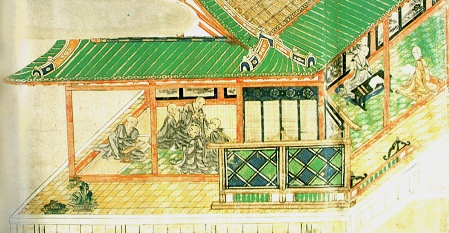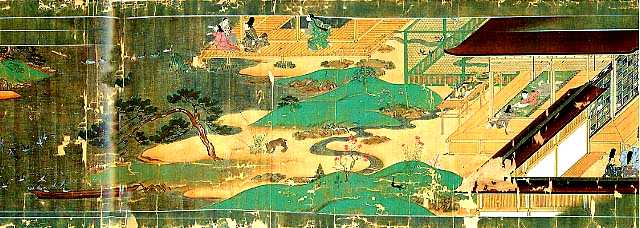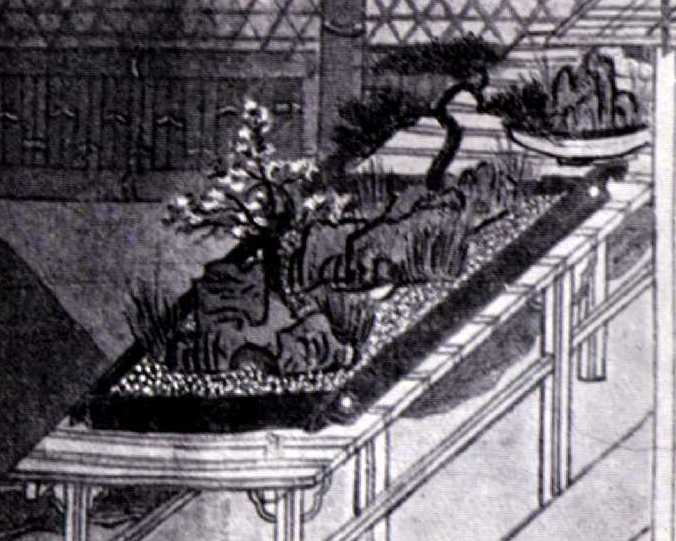|
The Work: From about the year 1195, comes the earliest known depiction in Japan of a dwarfed potted tree. Saigyo Monogatari Emaki ( Biography of Monk Saigyo ) shows the deeds and experience of the poet-monk Saigyo. One section of the scroll has a dwarfed tree in a ceramic container, a hobby and status symbol of the privileged class to which Saigyo (aka En-i, 1118-1190) belonged. 
The Subject:
Born Norikiyo into the Sato
sub-branch of the vast and powerful Fujiwara clan, he became a captain
in an elite corps of guards who protected the imperial family and the highest
courtiers. Suddenly at age twenty-three, he asked permission of the
emperor to leave his commission, and then abandoned his wife and children.
(There is some historical question whether or not he had a wife at the
time, or more than just one son.) Becoming a bonze, he travelled
throughout the provinces preaching, reciting poetry and demonstrating the
bow, at which he had always been an expert.
The Author: Attributed to Fujiwara Tsunetaka (active late 12th to early 13th cent.). 1
The Work:
The ink and color on silk scroll
Ippen Shonin Eden
is dated from 1299. A series of forty-eight scenes mounted on
twelve scrolls. Contrary to the practice of the time when paper was the
usual support for scroll paintings, this work is carefully executed on
silk, which goes to show the importance attached by the brotherhood to
the life story of its founder. In the sixth scroll occurs
one of the earliest representations of Mount Fuji, already reflecting
the feeling of the Japanese for their beautiful mountain. Current
locations: Kankikoji temple in Kyoto and the Tokyo National Museum.
The Subject:
Ippen Shonin (1239-1289) was born Ochi
Michihide, and at age seven entered the Tendai's Keikyo-ji temple.
There he successively studied the Tendai, Jodo, and Nembutsu sects.
After studying these and
meditating on them in solitude for many years, Ippen developed the
theory of self-sacrifice in the charity of Amida, founded the Ji-shu
sect, and spent the rest of his life traveling through the length and
breadth of Japan, converting over two and a half million people. He is described as a revivalist preacher.
"Shonin" (lit. "superior man") was a suffix added to
names of certain bonzes famous for their virtue. Shortly after
his death, the story of his life was written by Shokai (1261-1323), his favorite
disciple and younger half-brother, who had faithfully accompanied him in all his wanderings.
The text on the scrolls is this biography.
The Author: Attributed to E'ni, who no doubt was a fellow pilgrim of the great monk. As the scrolls are unrolled, we almost seem to be following the itinerary at Ippen's side, in the small company of his favorite disciples, visiting the famous places and leading temples of each province. So closely do the landscapes and buildings represented resemble those still in existence today, that we are forced to conclude that En-i drew these scenes on the spot in the course of his pilgrimage and based his work on these drawings. This procedure gives his paintings an unusual style and flavor, faithfully reflecting the varied aspects of Japan's natural scenery, from region to region and season to season. At the same time he draws a complete picture of the age: nobles and warriors, tradesmen and peasants, and even beggars and vagabonds, are recorded by the artist with such a wealth of detail that these scrolls hold the mirror up to Japanese society in the Middle Ages, comparable in this respect to the masterworks of Western miniature painting of the same period. 2 The Works: There are said to be two early works, Natural Methods of Figure Painting (1300) and A Collection of Springtime Sketches (1304) which contain pictures of dwarf potted trees. 3
The Work:
From 1309, comes a twenty-scroll
emaki-mono
titled
Kasuga-gongen-genki
(
The Incarnations and Miracles at the Kasuga Temple
).
It is one of the rare Kamakura-period picture scrolls to be written and
painted on silk. (A twenty-first scroll carries the table of
contents and a preface.) These scrolls are also a valuable historical record of a variety of
architectural styles.

Seen in the above section about one-third of the way from the right edge (where the gate and approaches to the mansion are crowded with visitors, not shown here), a birdcage and these tray landscapes add to the revelation of the owner's wealth along with the spaciousness and rich decoration of the architecture. The miniature landscapes are probably exotics imported from the mainland. The box or tray is filled with earth to suggest hills planted with trees neatly encircled by small light-colored pebbles. Two light-blue dish-like pots on the other end of the bench also has this same ground cover. The beautiful pots of Chinese origin played a major role in the appreciation of dwarf potted trees. The two together must form a single entity. (Even to this day, the most highly sought after containers for the finest bonsai in Japan are very often antique Chinese pots.) Were the plants in the trays also from China? How long did the original plants last and were they replaced? Whatever became of these possessions or this residence? Why didn't flat trays "catch on" in Japan this early? 
The Artist:
Takakane Takashina was a
Yamato-e painter known to have been attached to the Imperial Court painting
bureau as chief painter at least during the years 1309-1330. His
commissions included making copies of several earlier paintings -- an
art tradition in both the East and West which faded only with the development
of lithography and photography -- of Buddhist deities and festivals and
historical subjects. At the request of the powerful political leader
"The Minister of the Left" Saionji Kinhara (1264-1315), Takakane executed the series of scrolls to
be presented to the Kasuga Shrine in Nara for dedication in March
1309 (Engyō 2.3).
This was the patron shrine of the Fujiwara family, of which the Saionji
family was an offshoot.
The Work:
From the year 1317 comes
Honen Shonin Eden
(
Life of Saint Honen in Pictures
), a series of forty-eight
scrolls. Each of the scrolls, on an average, measures thirty feet in
length. A detailed study of it made by Shimada Shujiro has shown that
this set of scrolls, begun at the emperor's behest in 1307, was twice
added to and finally completed--or brought to the stage at which we now
have it--toward the second half of the fourteenth century. The
seventh scroll has a small/medium-sized rock-growing tree in a
bowl/dish on the veranda outside of where the seated and praying Honen
is having a vision of a white elephant, a venerated animal in India
(for both the Buddhist and Hindu faiths) and in lands directly to its
east. Scroll #46 shows a larger aged tree in a deeper pot on a rectangular
wooden table. A small bowl of companion grasses resting on a small display
stand is also on the table. The potted tree is historically significant in that
it uses deadwood branches for what is clearly a calculated artistic effort.
Current location: Zojoji temple.
The Artist: Attributed to Tosa Kunitaka, but probably the work of many artists. 5 |